The Gator Prime system was designed using biolayer interferometry (BLI) technology, which allows for real-time monitoring. This device can be used at different stages of therapeutic development to assist in the analysis of biological molecules.
The Gator instrument helps to quantify the interference pattern generated by fluctuations in protein concentrations localized to the probe tips. This is useful for examining protein–protein interactions, such as determining binding constants, off-rate screening, affinity maturation, yes/no binding to target antigens, and epitope binning.

Image Credit: Gator Bio, Inc.
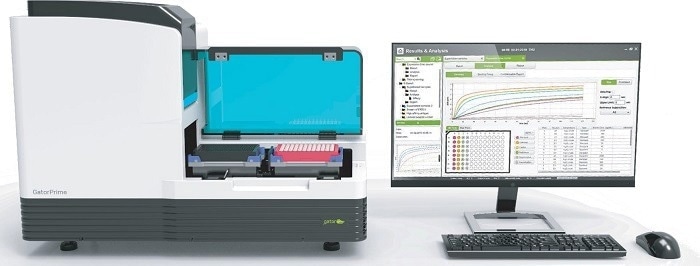
Image Credit: Gator Bio, Inc.
The GatorPrime System
The GatorPrime system is comprised of instrumentation, software, and a selection of probes. The integrated software combines acquisition and analysis to enable setup from beginning to end. On the GatorPrime system, several ELISA tests, such as antibody titer measurement and isotyping, can be easily implemented.
Table 1. Source: Gator Bio, Inc.
| Gator probe |
Function |
Application |
Dynamic range |
Regeneration |
| Protein A |
Binds IgG’s of various species, including human and mouse |
Q/K/QKR |
0.02 – 2000 μg/mL |
Yes |
| Protein G |
Binds IgG’s of various species, including human and rat |
Q/K/QKR |
0.02 – 2000 μg/mL |
Yes |
| Protein L |
Binds IgG’s of various species through the kappa light chain |
Q/K/QKR |
0.1 – 2000 μg/mL |
Yes |
| Human Fc |
Immobilize human Fc-fusion protein or human IgG for quantitative or kinetic analysis |
Q/K/EP |
0.02 – 300 μg/mL |
Yes |
| Mouse Fc |
Immobilize mouse Fc-fusion protein or mouse IgG for quantitative or kinetic analysis |
Q/K/EP |
0.02 – 300 μg/mL |
Yes |
| Anti - FAB |
Binds F(ab), F(ab’)2, Fc receptor, and full length Human IgG |
Q/K/QKR/EP |
0.3 – 3000 μg/mL |
Yes |
| Anti – His |
Binds His-tagged proteins |
Q/K/QKR/EP |
Protein-dependent |
Yes |
| Streptavidin (SA) |
Binds biotinylated and Avi-tagged biomolecules |
Indirect Q/K/EP |
Protein-dependent |
No |
| Small Molecule, Antibody, and Protein (SMAP) |
Binds biotinylated and Avi-tagged biomolecules and subsequent binding of small molecules and protein |
Indirect Q/K |
>150 Da |
No |
| APS (Aminopropylsilane) |
Binds hydrophobic proteins |
Q |
Protein-dependent |
No |
| Amine-Reactive |
Covalently attach amine group of proteins using EDC/NHS |
Indirect Q/K/EP |
Protein-dependent |
No |
| Custom-Made |
Custom-made biosensors for your specific applications (Ex: SARS-CoV-2 R&D biosensors for COVID research) |
Varies |
Varies |
Varies |
Epitope Binning With Gatorprime System
When an antibody binds to an antigen, it does not bind to the complete protein sequence. Instead, the antibody attaches to a segment of the antigen that is approximately five or six amino acids long.
As such, a typical protein contains numerous epitopes to which antibodies bind. When it comes to epitope binning, antibodies are evaluated in a paired combinatorial manner, and those that compete for the same binding area of the antigen are put together into bins.
An epitope bin is a relative concept determined by the epitopes represented in the evaluated mAb panel.
Based on signal fluctuations or nanometer shifts, the GatorPrime system tracks real-time binding and determines whether a certain antigen-antibody pair should be in the same epitope bin.
Gator Bio probes (Mouse Fc, Human Fc, Anti-His, etc.) are available for epitope binning. The experiment can be configured to run in premix, in-tandem, or traditional sandwich forms. The materials and probes can be used multiple times.
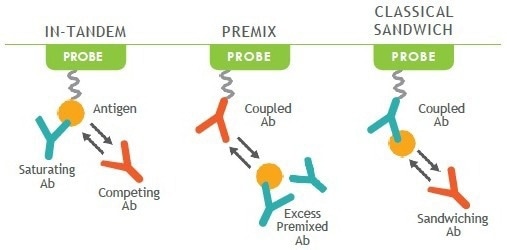
Image Credit: Gator Bio, Inc.
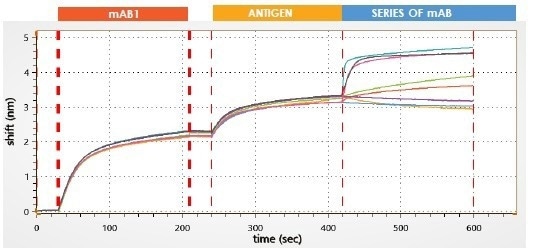
Epitope binning binding curve using in-tandem assay. Image Credit: Gator Bio, Inc.
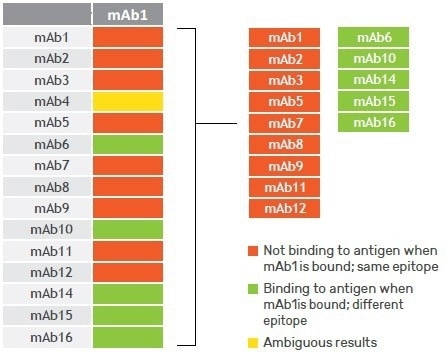
Epitope binning against supernatant. Image Credit: Gator Bio, Inc.
Antibody Titer Using Gator Bio Protein A Biosensors
High-sensitivity Gator Bio Protein A biosensors enable the efficient and specific capture of any Fc-tagged protein that binds to protein A. In most commercially available media, the dynamic range of Gator Bio Protein A biosensors spans from 25 ng/mL to 2 mg/mL. This allows for a wide range of hybridoma supernatants to be investigated using a single setup.
Gator Bio Protein A biosensors may be regenerated up to 20 times under simple regeneration conditions, and the same biosensors can be used for several days.
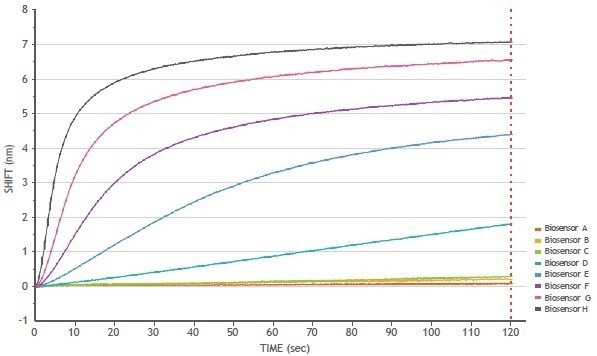
Standard curve for human IgG binding to GatorPrime Protein A biosensors. Image Credit: Gator Bio, Inc.
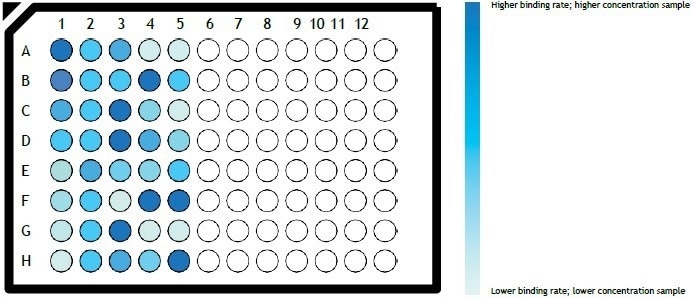
Heat map generated by GatorPrime software for human IgG concentration analysis using Gator Bio Protein A biosensors. Image Credit: Gator Bio, Inc.
Kinetic Characterization Using the Gatorprime System
The Gator system can also be used to determine the kinetics of a drug molecule interacting with its target. The system enables quick measurements of the dissociation rate (koff), association rate (kon), and equilibrium dissociation constant (KD) of antigen-antibody interactions with or without labeled reagents.
Alternatively, the Gator system can be used for primary kinetic screening of antibody libraries in various crude media to determine off-rate ranking and comprehensive binding characterization of a purified antigen-antibody binding pair.
An extensive range of probes are available for the kinetic characterization of biological samples. In general, Gator Bio biosensors are highly adaptable and regenerable (excluding the SA biosensors) and can be used multiple times. This capability enables the user to establish several real-time binding assays with blank sensors and proper controls to get high-quality binding data.
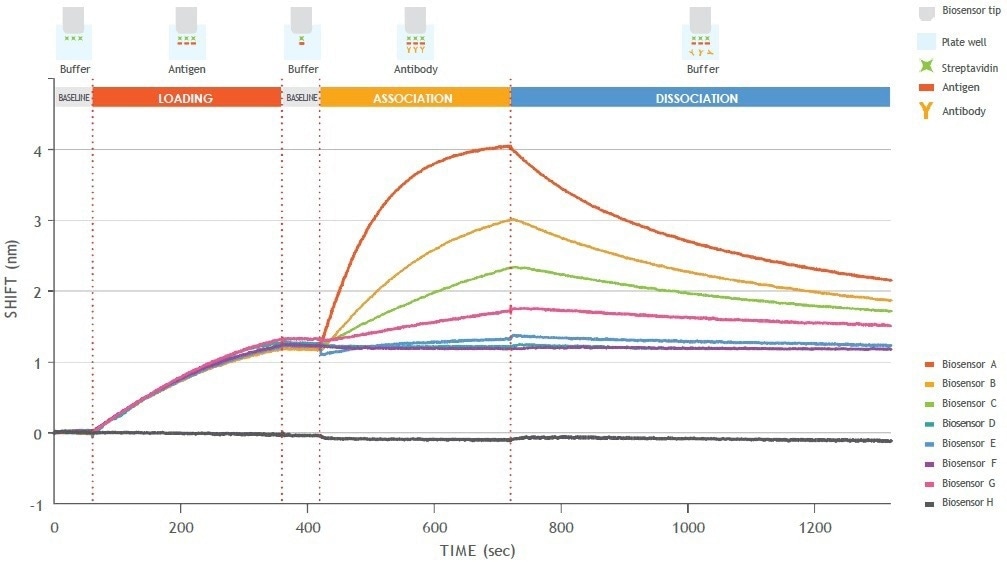
Kinetic analysis of a purified antigen-antibody pair using Gator Bio Streptavidin biosensors. Image Credit: Gator Bio, Inc.
Highlights
- Eight various binding reactions can be performed at the same time
- A wide range of biosensor choices to quantify binding kinetics
- Easy to customize assay and fine-tune concentration ranges of analyte to get precise binding constants
- The binding constant can be identified within 20 minutes
Antibody Isotyping and Subtyping with Gatorprime System
Immunoglobulins, or antibodies, can be divided into five categories: IgA, IgD, IgG, IgE, and IgM. Within these five primary classes, different species may have different subclasses or isotypes of antibodies.
These subclasses differ in the disulfide links that connect the antibody's two heavy chains in the constant region. For example, mice have IgG1, IgG2a, IgG2b, and IgG3. Gator Bio Human Fc (HFC) and Mouse Fc (MFC) biosensors are commonly used to determine isotypes (IgG1, IgG2a, etc.).
Users are able to definitively verify the presence of antibody subtypes in crude samples, like hybridoma supernatants, thanks to the availability of Gator software.
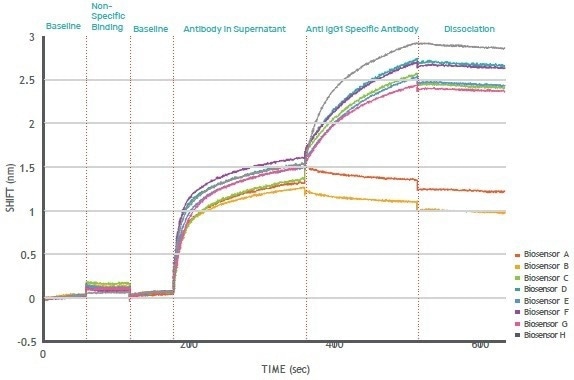
Hybridoma supernatant isotyping using Gator Mouse Fc biosensors. Image Credit Gator Bio, Inc.
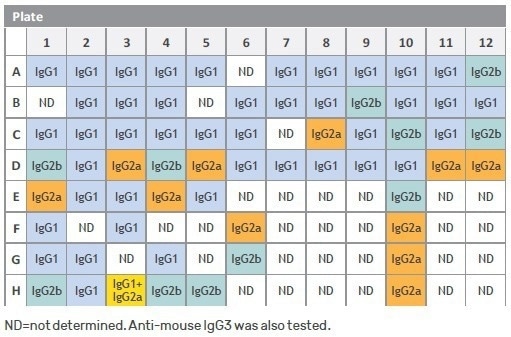
96-well plate with unknown isotypes of mouse IgG hybridoma supernatant characterized using Gator Mouse Fc biosensors. Image Credit: Gator Bio, Inc.
Highlights
- Antibody isotype determination can be performed even in crude samples
- Regenerable biosensors to save time and assay or cost
- High sensitivity
- Visual real-time binding outcomes
General
Table 2. Source: Gator Bio, Inc.
| GENERAL |
| Detection |
Biolayer interferometry |
| Number of channels |
8 |
| Data collection rate |
2 Hz, 5 Hz, 10 Hz |
| Orbital flow |
0 – 1,500 rpm |
| Instrument |
460 mm x 670 mm x 320 mm (H x W x D)
30 kg |
| Electrical |
110 V – 220 V 5 A |
| Power |
200 W |
Software
- Smart search and a preview of outcomes
- Enables initiation of the next assay while the present one is in progress
- QKR — quantitation, kinetics, and regeneration in one run
- Real-time display of quantitative outcomes and heat map
- Operating system: Windows 10 Professional 64-bit
- Combined data acquisition and analysis
- Data analysis templates available for multiple binding models
- Epitope binning setup and analysis
Analysis
Table 3. Source: Gator Bio, Inc.
| ANALYSIS |
| Sample types |
Proteins, antibodies, peptides, DNA, RNA, liposomes, cells, viruses, etc. |
| Work flow |
- 2 x 96-well plates, in tilted or flat position
- Up to 8 samples in parallel, up to 96 samples per 96-well plate
|
| Types of analysis |
- Yes or no binding
- Relative and absolute concentration
- Kinetics and affinity
|
Quantitation
Table 4. Source: Gator Bio, Inc.
| QUANTITATION |
| Analysis time |
- IgG concentration in 30 seconds for 8 samples
- <10 minutes for 96 samples
|
| Linear range for Gator Protein A biosensor |
0.025 – 2,000 μg/mL |
Kinetics
Table 5. Source: Gator Bio, Inc.
| KINETICS |
| Analysis time |
Real-time kinetic binding from 1 minute to 4 hours |
| Association rate kon |
101 – 106 M-1 /s |
| Dissociation rate koff |
10-6 – 10-11 /s |
| Affinity constant KD |
10 pM – 1 mM |
| Binding curve baseline noise |
<3 pm (RMS) |
| Binding curve baseline drift |
<40 pm/hour (RMS) |